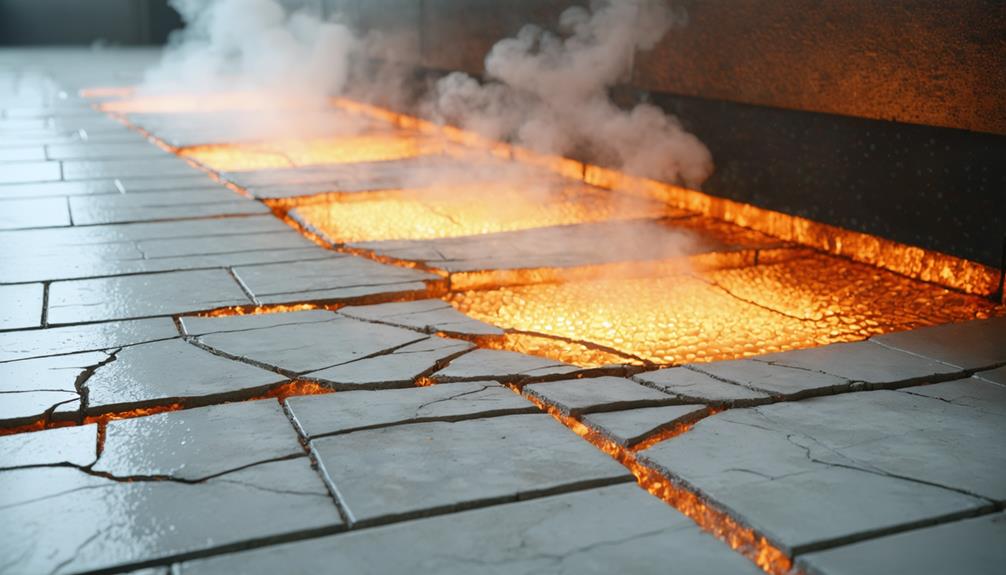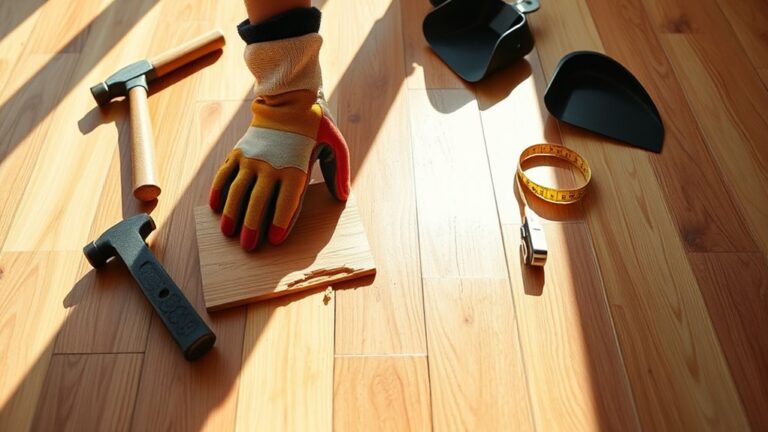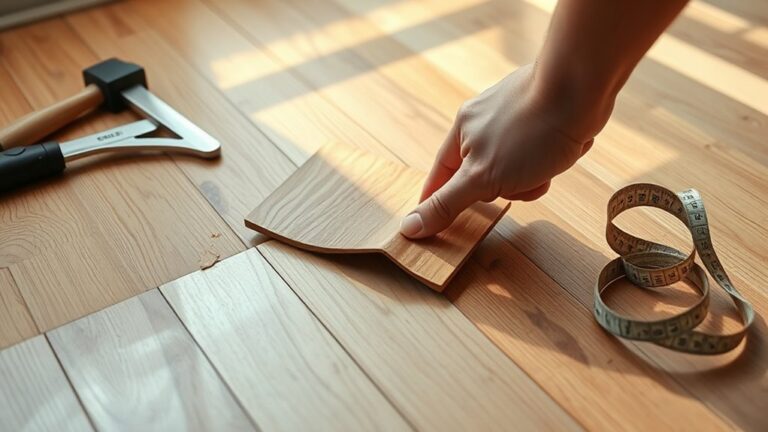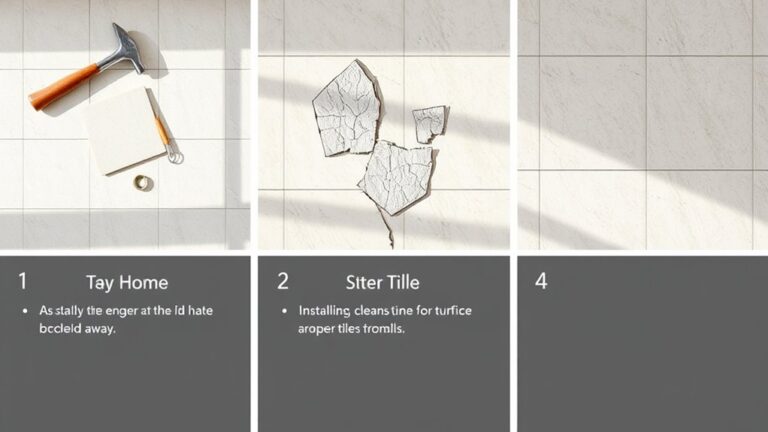Heated floors can cause floor cracking due to temperature fluctuations that lead to thermal expansion and contraction of materials. If installation isn't done correctly, rigid materials may develop significant stresses and cracks. Using improper adhesives or neglecting to install expansion joints heightens risk. Additionally, heavy weight or poor condition of the underlying concrete slab contributes to cracking. To mitigate these issues, consider using anti-fracture membranes and flexible grout types, which accommodate temperature shifts better. Understanding proper installation techniques and material properties is essential for prevention. There's much more insight available to help you avoid these common pitfalls.
Understanding Floor Cracking Causes
Understanding the intricacies of floor cracking is essential for maintaining the integrity of your flooring. Tile cracking often results from temperature fluctuations, which can be exacerbated by a heating system that causes uneven heating in your flooring. When the temperature changes, materials expand and contract, and if the flooring material is sensitive to these variations, it leads to stress that can manifest as cracks.
Improper installation plays a significant role in susceptibility to cracking. If tiles are not adequately adhered or lack sufficient support beneath, the structural integrity is compromised, increasing the likelihood of cracks under normal wear and tear. Additionally, excessive weight or pressure on the tiles can generate localized damage, which may develop into cracks over time, especially if the underlying support is inadequate.
Another critical factor to reflect on is the condition of the concrete slab. Significant temperature differences within the slab can intensify cracking, particularly if insulation is insufficient. This uneven temperature distribution can create stress points where cracks are likely to form.
To mitigate these risks, incorporating anti-fracture membranes during tile installation is advisable. These membranes can absorb temperature changes and provide a buffer against the stresses that lead to cracking. By understanding these causes, you can take proactive measures to maintain your flooring's integrity and avoid the costly repairs resulting from tile cracking.
Role of Thermal Expansion
Thermal expansion plays an important role in the integrity of heated floors, as materials inherently respond to temperature changes by expanding and contracting. When you install radiant heating, the temperature fluctuations can create considerable differences between the heating source and the surrounding flooring materials. This disparity increases the likelihood of thermal expansion-related stresses, which can ultimately lead to cracking if not effectively managed.
Different flooring materials exhibit varying levels of thermal expansion. Rigid materials, for instance, are more susceptible to cracking than their flexible counterparts. As the heated floor warms up, the rigid materials expand; when they cool down, they contract, but if this movement is restricted, cracks can form. Therefore, understanding your chosen flooring material's expansion properties is vital.
Furthermore, the use of proper installation techniques, such as incorporating expansion joints, can greatly mitigate the risk of cracking. These joints allow for necessary movement due to thermal expansion, accommodating the natural shifts in the materials without causing damage.
Importance of Proper Installation
The foundation of a successful heated floor installation lies in its proper execution. Without meticulous attention to detail, you're opening the door to potential issues like cracking, which can derail the comfort and aesthetics of your space. The heating element must be installed accurately, guaranteeing that it operates efficiently without causing undue stress on the flooring materials.
To highlight the importance of proper installation, consider these points:
- Your investment deserves the assurance of longevity.
- You want the freedom to enjoy a warm floor without worries.
- A well-installed system enhances your living environment.
Proper installation is essential to prevent thermal expansion and contraction that can lead to cracks over time. It's critical to verify that adequate adhesive and cement are applied during the installation process. This supports the tiles effectively, reducing the risk of cracking due to insufficient bonding. Following the TCNA guidelines for underlayment and support is fundamental to maintain the integrity of your floor and prevent deflection, a common cause of cracks.
Incorporating anti-fracture membranes can further protect against cracking by absorbing temperature fluctuations and movement within the floor structure. While DIY solutions might seem appealing, professional installation is often recommended to guarantee compliance with best practices. Remember, a small oversight during installation can lead to significant problems down the line, impacting both the performance of your heating element and the overall durability of your floor.
Preventative Measures for Cracking
While heated floors offer comfort and warmth, taking preventative measures against cracking is imperative to maintain their integrity. To effectively prevent cracking, begin with the installation of anti-fracture membranes. These membranes absorb temperature changes and help manage thermal movement, greatly reducing the risk of cracks in both tile and grout.
Next, guarantee that the proper adhesive and cement are utilized. A secure bond between tiles is essential, as it minimizes movement that can lead to cracking under the stress of heated expansion and contraction. Additionally, planning for expansion joints in heated screed floors is critical. These joints accommodate thermal movement, acting as strategic weak points to dissipate stress and prevent cracks from forming.
When selecting materials, consider using flexible grout types, such as Quartzlock. These products enhance durability and flexibility, allowing for easier adaptation to temperature fluctuations without compromising the floor's structural integrity.
Lastly, regular maintenance and inspections are important. By routinely evaluating your heated floors, you can identify and address any potential issues before they escalate into considerable damage. This proactive approach not only prolongs the life of your flooring but also guarantees that your investment in heated floors continues to provide comfort without the worry of cracking. Implementing these preventative measures will go a long way in safeguarding your floors against the adverse effects of thermal movement.
Expert Recommendations and Insights
Expert insights emphasize that proper installation is essential for preventing cracking in heated floors. When you're considering heated tile floors, a few key installation techniques can make all the difference in ensuring longevity and performance.
- The right installation can save you from costly repairs down the road.
- Avoid the frustration of constant maintenance and replacements.
- Experience the comfort of worry-free heated floors all year round.
To minimize the risk of cracking, employing anti-fracture membranes during installation is important. These membranes act as a buffer, absorbing stresses that would otherwise transfer to your tiles. Additionally, selecting flexible grout types like Quartzlock can help accommodate thermal expansion and contraction, thereby reducing the likelihood of grout cracking.
It's essential to adhere to the guidelines set by the Tile Council of North America (TCNA) regarding underlayment and support. Neglecting these standards can lead to unacceptable deflection in the floor, a primary contributor to tile and grout fractures.
Strategically placed expansion joints also play a significant role; they allow for thermal movement, which is particularly important in heated screed floors. This simple yet effective measure can help maintain the integrity of your installation over time. By following these expert recommendations, you can enjoy the benefits of heating without the stress of cracks ruining your beautiful tile floors.
Frequently Asked Questions
Can Underfloor Heating Cause Tiles to Crack?
While underfloor heating can provide comfort, it's essential to take into account the potential for tile cracking. If you don't use proper installation techniques, tiles may struggle with expansion due to temperature fluctuations. Poor adhesive or inadequate support can exacerbate these issues. However, when you strategically apply anti-fracture membranes and select flexible grout, you can greatly reduce the risk of cracking, allowing you the freedom to enjoy your heated floors without worry.
Why Does My Floor Crack so Much?
If your floor cracks frequently, it's crucial to take into account factors like floor movement, humidity levels, and installation quality. Variations in humidity can cause materials to expand or contract, leading to cracks. Poor installation practices, such as inadequate adhesive or insufficient underlayment, can exacerbate these issues. Furthermore, if the flooring isn't designed to accommodate movement, stress fractures may develop over time, compromising the overall structural integrity of your flooring system.
Can Radiant Heat Crack Concrete?
Radiant heat itself doesn't crack concrete, but it can contribute to issues if not managed correctly. As temperatures change, concrete expansion and contraction occur, leading to thermal stress. If your installation lacks proper design features, like expansion joints, or if the materials aren't suitable, you might experience cracking. To mitigate this risk, guarantee you use anti-fracture membranes and maintain adequate adhesive beneath tiles, allowing for movement without compromising the integrity of your floor.
What Is the Life Expectancy of a Heated Floor?
Heated floors can last over 20 years, especially with proper installation techniques and adherence to manufacturer guidelines. You'll want to focus on quality materials for durability. Regular maintenance tips, like inspections, can prevent issues that shorten lifespan. Energy efficiency is another essential factor; systems that operate at peak performance not only last longer but also reduce your energy bills. By prioritizing these aspects, you can maximize the life expectancy of your heated flooring.




